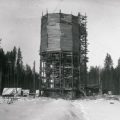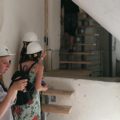The designers of a water tower whose construction began in 1929 in a settlement near Uralmash machinery plant could hardly imagine that this structure would become known by its proper name, turn into a city landmark and acquire the status of an architectural monument, only to be abandoned for more than half a century.
In 1920s in Sverdlovsk, as Yekaterinburg was called at that time, construction of Uralmash started. The plant was to become the flagship of Soviet heavy machinery industry. Industrial township grew around it, and the problem of water supplies arose. It was decided to pump water from the nearest lake, Shuvakish.
A creative approach was taken, and the contest for the design of the water tower was announced. The winner was a young architect Moisei Reischer who was 26 at that time. He came up with a unique design overnight. After some minor tweaks and addition of round windows, the project was accepted for execution.
Uralmash construction workers began to erect the tower under the guidance and supervision of Moscow specialists. And yet an incident occurred. Initially, the bottom plate of the tank was made of welded metal, and when it was filled with water during the test run, the bottom began to bend and then burst open. After that, the reinforced concrete floor was urgently devised. In 1931, when the tower was commissioned, the 700 cubic meter water tank was the largest in the world. It was welded right on the spot, and at night one could see the blue welding lights even from Sverdlovsk. And it turned out to be something special! The tank, through its reinforced concrete ring, rests on four points: two free-standing supports and two brick walls of the staircase. Located at the highest point of the settlement, the tower has become its architectural symbol. Upon completion, the tower was whitelimed, hence the name. The tower changed its color only once, during the World War II, when it was painted in khaki shade for disguise.
Over time, the workers’ settlement grew so large that even the giant tank could no longer maintain the required water pressure. Lake Shuvakish was nearly drained, and the tower became irrelevant. It stopped functioning in the 1960s, and in 1974 it turned into an architectural monument. Uralmash watched over the structure in the Soviet years, but in 1990s the plant itself faced difficulties, and the tower decayed. The city could not afford its maintenance, and there were constant disputes about who should restore the abandoned structure. In 2006, the building was taken over by the Red Cross, but that did not change much.
The local enthusiasts returned the architectural monument in the spotlight for the residents and authorities of Yekaterinburg. In 2012, a group of young architecture students named PODELNIKI was established. Group members initiated works to save and preserve the tower, cleaned it of debris and made it safe to visit, installed electricity and heat guns. Since August 2016, the White Tower has been operating as a museum of itself: visitors can watch a film about the history of the monument on a multimedia screen, take part in guided tours and cultural events, and buy souvenirs. All raised funds are used to finance the further restoration of this symbol of the Constructivist era. This means that the famous White Tower is coming back to life.
Elena Malinovskaya




